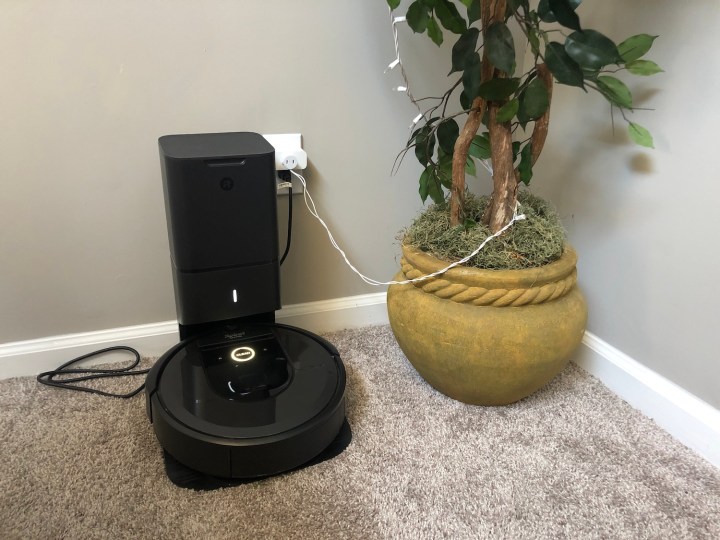Many robot vacuums are smart enough to automatically clean your home, but most lack the ability to empty their dustbins. That means you’ll still be fussing with a dirty robot vacuum — which sort of defeats the entire purpose. However, if you step up to a premium model like the iRobot Roomba j7+, you’ll benefit from a device that knows how to empty itself when its dustbin is full.
The capability can even be found on some midrange models, but is a self-emptying robot vacuum necessary? Or should you save the extra cash and opt for an entry-level robot that lacks the feature? Here’s a closer look at the benefits and drawbacks associated with self-emptying robot vacuums.
What is a self-emptying system?
As a robot vacuum cleans, it pulls debris into an interior storage system — usually a relatively small dustbin. Depending on the size of your home and how dirty the floor is, you may have to empty the dustbin every two or three cleaning cycles.

A self-emptying system provides a dock for the robot vacuum to rest in that not only charges the device, but also connects it to a series of vacuums that pull the dirt and debris out of the dustbin and into a much larger storage bin. Think of it like the bag on a traditional vacuum cleaner. You just empty the base station every 30 or 60 days rather than every two or three days.
The benefits of self-emptying robot vacuums
The convenience of a robot vacuum is that it does the cleaning for you. The more hands-off it is, the better. Imagine a busy parent in the middle of the week. They’re handling kids, work, and a host of other household chores. In the middle of it all, they have to stop to empty the vacuum. Not needing to vacuum is a benefit, but if you have to stop multiple times throughout your day just so the robot vacuum can continue its job — especially in a big house — those benefits are somewhat negated.
A self-emptying system also means you can run the robot vacuum more often. If you know you have to step in and empty the dustbin throughout the day, you might be hesitant to use the vacuum more than what’s absolutely necessary. On the other hand, if it empties itself, you can run it much more often and keep your home that much cleaner.

Following that same line of thought, you can make better use of a robot vacuum in larger homes. If you have to empty the vacuum multiple times per run, it means you can’t really make use of a cleaning schedule. You have to be home when the vacuum runs. With a self-emptying base, even people in much larger homes can set their vacuum to run and forget about it.
Storage bags within self-emptying systems are designed to contain dirt and debris without letting anything out; in other words, even with a bag full of pet hair and dander, you don’t have to worry about allergies just from being near the base station. Plus, the blowback that most people experience when emptying their bot’s dustbin is eliminated, so there’s no more thin layer of dust on your hands after it’s emptied!
The downsides of self-emptying robot vacuums
With robot vacuums, the pros definitely outweigh the cons — but there are still things of which to be aware.
The first is the size. A robot vacuum requires a certain amount of space on either side of it and in front of it (usually 1.5 feet and 4.5 feet, respectively), but you can often place it under a table or tucked out of the way until needed. With the addition of a self-emptying base, it takes up far more room.

For example, the iRobot Roomba i7 Plus Clean Base is 19 inches tall and 12 inches wide, with a slight ramp in front of it that the Roomba rests on. It requires much more floor space than a robot vacuum on its own.
Another downside is the noise. While brief, the process of emptying the dustbin is loud. While no robot vacuum is considered quiet — it is a vacuum cleaner, after all — most are quiet enough that they won’t actively bother you. On average, robot vacuums fall somewhere in the 60 to 70 decibel range. The self-emptying process is easily 10 decibels louder.
The final downside is the cost. The iRobot Clean Base is an extra $250, while the dirt storage bags are roughly $5 each and offered in packs of three. The same can be said about the Shark IQ’s self-emptying base, which commands the same $250 additional charge. That’s not pocket change, especially when combined with the cost of the robot vacuum itself.
Is a self-emptying robot vacuum worth it?
A robot vacuum without a self-emptying base is worth it, but it is definitely more worth it with one. The self-emptying base adds a fair amount of value and convenience to any compatible robot vacuum. It’s especially valuable if you have individuals at home who are more sensitive to dust and allergens. You’re less likely to reintroduce debris if you go with a self-emptying bot.
It’s even more valuable if you live in a large house with a lot of floor space to cover. The robot vacuum will clean more efficiently, and you won’t have to empty it multiple times per run.
On the other hand, if you live in a studio apartment, it might be better to purchase just the robot vacuum and invest in a self-emptying base later. The large size of the base station dominates a decent amount of space and would not yield as many benefits in a smaller area.
Editors’ Recommendations
Credit: Source link



Comments are closed.